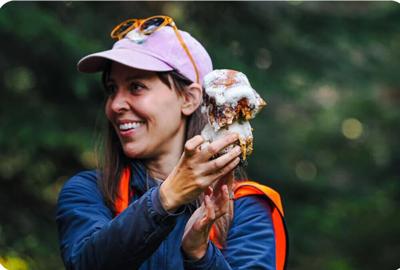HOOD RIVER — Did you know that mushrooms are more closely related to humans than plants? Well, Krista Cushman does, along with an encyclopedia of tips and tricks to help you identify them in the wild.
The Columbia River Gorge enthusiast, mycologist and Hood River educator shared an abundance of fungal facts and woodsy wisdom at the Columbia Center for the Arts on Nov. 12 — the second lecture in Mt. Adams Institute’s Sense of Place Season 16.
Identification
The Pacific Northwest is a mushroom paradise, abundant with countless species to observe, photograph, pick and cook. Our high-altitude environments, diverse landscapes and extreme dry and wet climate regions enable a wide range of fungi to flourish.
But before we can safely appreciate and engage with such a bounty, we must learn how to differentiate between them. While it’s true that some are delicious or make your backyard look whimsical, many are better to marvel at than to munch on or disseminate. “There’s no specific trait in mushrooms that tells us it’s edible,” Cushman said. “You have to know your mushroom before you eat it.”
There are several key characteristics to help categorize a forager’s find. A mushroom’s structure, scent, color, spores and mycelium can all help indicate its potential toxicity, edibility, species and ecological function. Such traits can also help one decide how to harvest a mushroom, whether via cutting or plucking.
Mycelium is a network of fungal threads at the base of the mushroom’s fruiting body, and it can present a variety of textures, patterns, colors and appearances. “Not all mushrooms have visible mycelium, but if yours does, that can help you identify it,” Cushman said. “If the body of the fungus is mycelium, then you can harvest the mushroom without destroying the organism.”
Then there’s the cap — the recognizable upper part of a mushroom’s fruiting body turned popular hat. “It can be velvety and round, really slimy, pointed like a gnome hat. It can have ridges and pits, be two-toned, flowery or leathery,” Cushman said. “They can fall apart when you pick them up. That’s an identifiable characteristic. That’s good information.”
A similar detailed examination can be exercised on the stem, or stipe, and the mushroom veil — a protective membrane that fully or partially encloses the fruiting body.
Spores, specifically spore-bearing surfaces, also aid in identification and can exhibit wildly different presentations. It’s essential to determine if a mushroom has gills, pores, teeth, spines or another unique spore structure. “The first time that I looked at spores under a microscope, I cried,” Cushman said. “They’re so beautiful.”
Lastly, a mushroom’s scent can be a distinguishing feature. “Really, mushroom hunting is about using your senses,” Cushman said. “They can be fruity, sweet, smell chemically or like vegetables. Smell all your mushrooms, you might get lucky.”
Ecological function
But mushroom identification isn’t just important for Instagram or culinary pleasure — every organism in the fungal kingdom plays a vital role in its ecosystem.
The very first mushrooms were parasitic, benefiting at the expense of a living host and harming it in the process. “There’s no more perfect example than the ‘humongous fungus’ in the Blue Mountains of Oregon,” Cushman said. “It’s estimated to be anywhere from 2,000 to 8,000 years old and is genetically the same over three and a half miles.”
Considered the largest living organism on Earth, the humongous fungus has been killing healthy trees for thousands of years, rotting and recycling them back into the soil.
Saprotrophic mushrooms, which include those commonly found in grocery stores and farmers’ markets, decompose dead wood and organic material, cycling nutrients so that plants can reabsorb them to fuel the next phase of forest growth. “They’re also used for micro remediation, like breaking down agricultural and plastic materials,” Cushman said. “This has propelled 90% of all decomposition on Earth.”
Then there are mycorrhizal fungi, which form beneficial relationships with plants, especially trees, by expanding water and nutrient absorption in exchange for sugars. “Some plants are completely dependent on mycorrhizal fungi for survival,” Cushman said. “This partnership isn’t the exception, it’s the rule.”
Call to action
Cushman concluded her lecture with a call to action, encouraging locals to engage directly with mushrooms, help document them and assist in conservation efforts. “People who are collecting data on mushrooms aren’t my colleagues or people in universities,” Cushman said. “It’s us, and it can help inform policies that will help protect the habitats that fungi depend on.”
Platforms like iNaturalist provide users a digital way to identify mushrooms in the wild and help experts gather more conclusive biogeographical data. Of course, its AI is subject to error. If you’re looking for a more human component, Cushman offers her time and would be happy to chat about and identify any fungal treasures.
“I’ve had mushrooms call to me. It was yelling at me so loudly it became rude to ignore it,” Cushman said. “And I believe that mushrooms are calling to you too, and all they want is your attention in return.”





















Commented
Sorry, there are no recent results for popular commented articles.